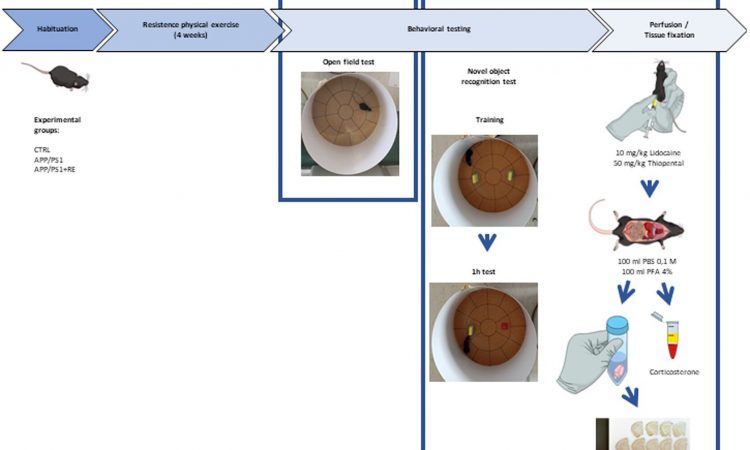
Regular physical exercise, such as resistance training, can prevent Alzheimer’s disease, or at least delay the appearance of symptoms, and serves as a simple and affordable therapy for Alzheimer’s patients. This is the conclusion of an article published in Frontiers in Neuroscience by Brazilian researchers affiliated with the Federal University of São Paulo (UNIFESP) and the University of São Paulo (USP).
Although older people and dementia patients are unlikely to be able to do long daily runs or perform other high-intensity aerobic exercises, these activities are the focus for most scientific studies on Alzheimer’s. The World Health Organization (WHO) recommends resistance exercise as the best option to train balance, improve posture and prevent falls. Resistance exercise entails contraction of specific muscles against an external resistance and is considered an essential strategy to increase muscle mass, strength and bone density, and to improve overall body composition, functional capacity and balance. It also helps prevent or mitigate sarcopenia (muscle atrophy), making everyday tasks easier to perform.
To observe the neuroprotective effects of this practice, researchers in UNIFESP’s Departments of Physiology and Psychobiology, and the Department of Biochemistry at USP’s Institute of Chemistry (IQ-USP), conducted experiments involving transgenic mice with a mutation responsible for a buildup of beta-amyloid plaques in the brain. The protein accumulates in the central nervous system, impairs synaptic connections and damages neurons, all of which are features of Alzheimer’s disease.
During the study, the mice were trained to climb a 110 cm ladder with a slope of 80° and 2 cm between rungs. Loads corresponding to 75%, 90% and 100% of their body weight were attached to their tails. The experiment mimicked certain kinds of resistance training undertaken by humans in fitness centers.
At the end of a four-week period of training, blood samples were taken to measure plasma levels of corticosterone, the hormone in mice equivalent to cortisol in humans; rising levels in response to stress heighten the risk of developing Alzheimer’s. Levels of the hormone were normal (equal to those found in the control group comprising animals without the mutation) in the exercise-trained mice, and analysis of their brain tissue showed a decrease in formation of beta-amyloid plaques.
“This confirms that physical activity can reverse neuropathological alterations that cause clinical symptoms of the disease,” said Henrique Correia Campos, first author of the article.
“We also observed the animals’ behavior to assess their anxiety in the open field test [which measures avoidance of the central area of a box, the most stress-inducing area] and found that resistance exercise reduced hyperlocomotion to similar levels to the controls among mice with the phenotype associated with Alzheimer’s,” said Deidiane Elisa Ribeiro, co-first author of the article and a researcher at IQ-USP’s Neuroscience Laboratory. Agitation, restlessness and wandering are frequent early symptoms of Alzheimer’s and other types of dementia.
“Resistance exercise is increasingly proving an effective strategy to avoid the appearance of symptoms of sporadic Alzheimer’s [not directly caused by a single inherited genetic mutation], which is multifactorial and may be associated with aging, or to delay their emergence in familial Alzheimer’s. The main possible reason for this effectiveness is the anti-inflammatory action of resistance exercise,” said Beatriz Monteiro Longo, last author of the article and a professor of neurophysiology at UNIFESP.
Review of the literature
The animal model study was based on a review of the literature published in Frontiers in Neuroscience, where the same group at UNIFESP compiled clinical evidence that the benefits of resistance exercise include positive effects on cognitive dysfunction, memory deficit and behavioral issues in Alzheimer’s patients, concluding that it can be an affordable alternative or adjuvant therapy.
Researchers from the Federal University of Rio Grande do Norte (UFRN) and the Federal University of Ouro Preto (UFOP) in Brazil also took part in the study.
“Alzheimer’s doesn’t only affect the patient. The entire family is affected, especially in low-income households,” said Caroline Vieira Azevedo, first author of the review article and a graduate student at UNIFESP. “Both articles offer information that can be used to stimulate the creation of public policies. Imagine the cost savings if the appearance of symptoms in older patients is deferred by ten years.”
More information:
Henrique Correia Campos et al, Neuroprotective effects of resistance physical exercise on the APP/PS1 mouse model of Alzheimer’s disease, Frontiers in Neuroscience (2023). DOI: 10.3389/fnins.2023.1132825
Journal information:
Frontiers in Neuroscience
Source: Read Full Article
